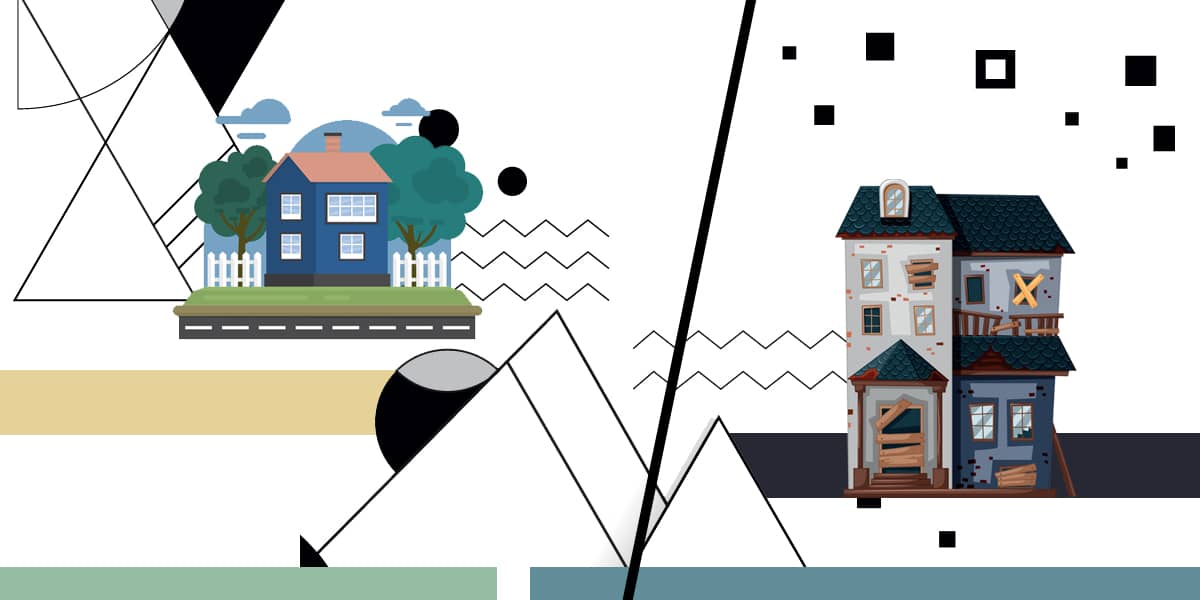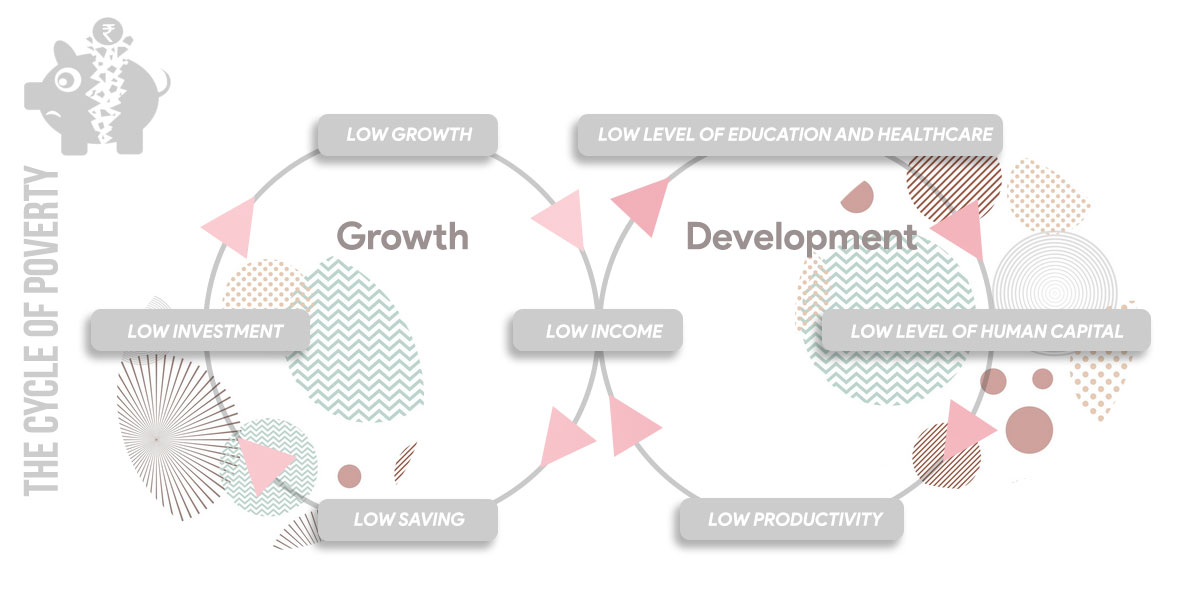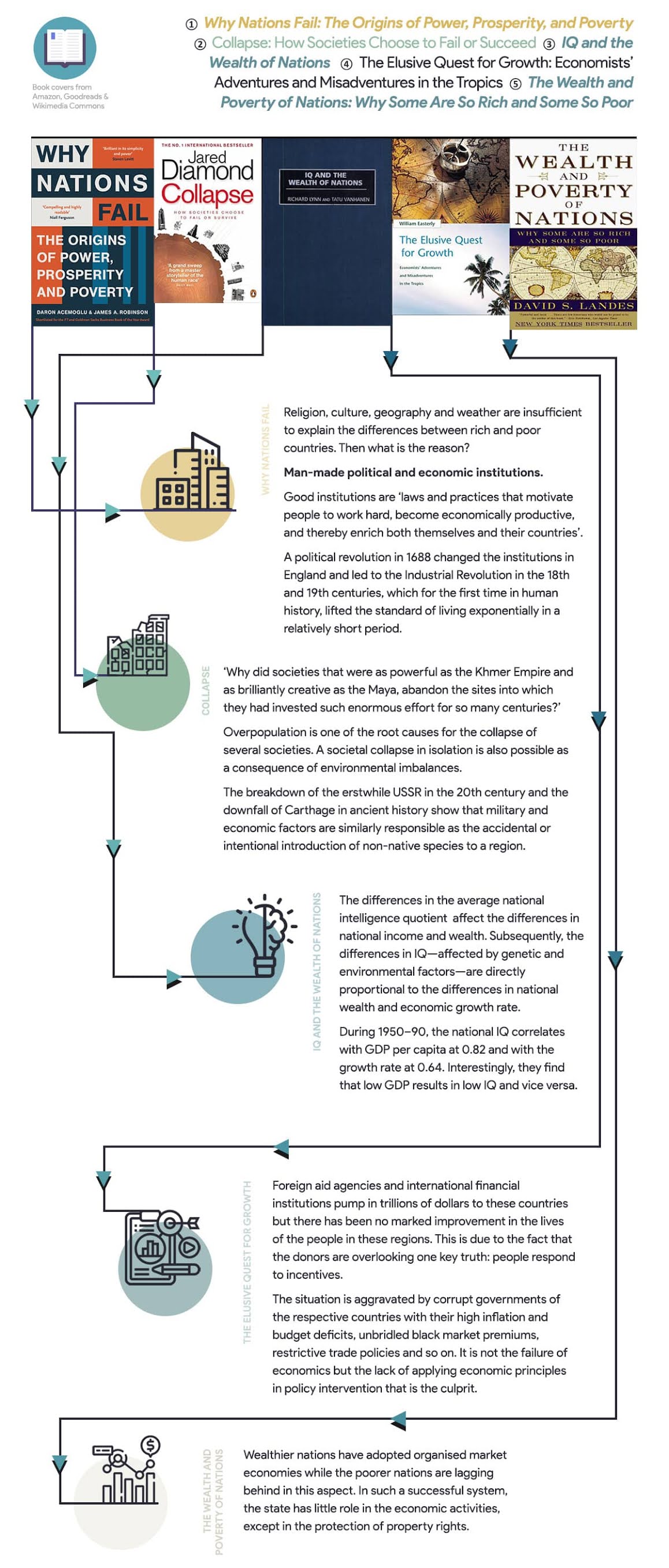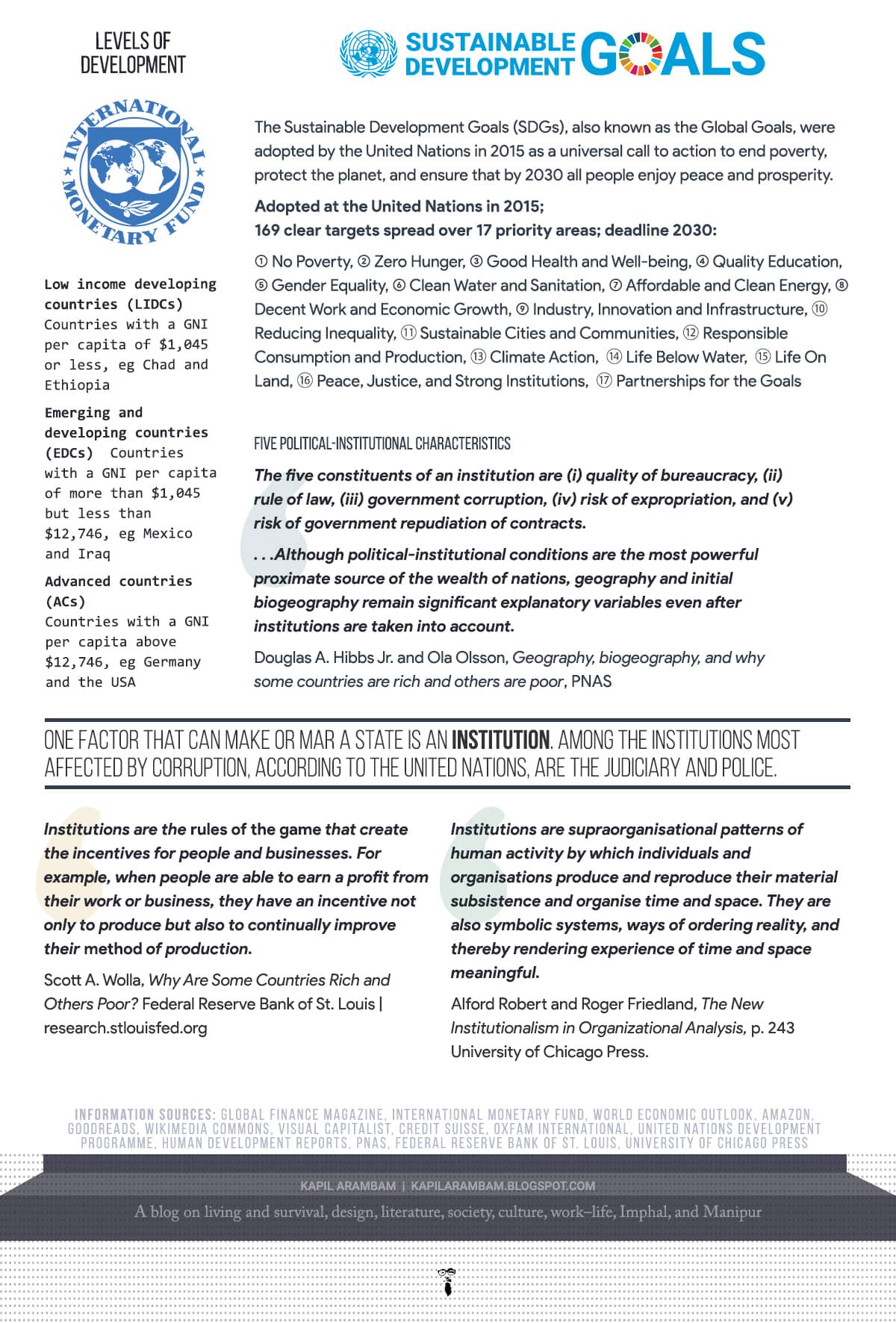2/2 Why Are Some Countries Rich and Others Poor? (A 2021 follow-up)
💰 Contents
- Introduction: Rich Countries, Poor Countries
- The Gap Between Rich and Poor Countries
- Economic Inequality – Gini Index, 2015 (Interactive graph)
- Rich Countries, Poor Countries and All of the World's Wealth (Infographic)
- The Institution of Prosperity and Poverty
- Epilogue
- Related Posts on this Blog
- Announcement
1/2 Why Are Some Countries Rich and Others Poor?
 |
| All the rich countries have superabundant trade and production. In contrast, poor countries have common characteristics of life and living marked by conflicts, wars and corrupt governments. |
Introduction: Rich Countries, Poor Countries
Five seminal books were referred to in a previous post, 1/2 Why Are Some Countries Rich and Others Poor? to answer this question. Let’s dig further and see more on the issue, and find which are the developed nations, how we measure the differences between rich and poor countries, what characterises poor countries, how we measure development, which major factors determine prosperity and poverty, and so on, with the help from reports on development and graphics that show concise information on these topics.
The following titles were referenced and had offered some insights into the phenomenon of prosperity and poverty. What are their narratives on rich-vs-poor countries?
① Why Nations Fail: The Origins of Power, Prosperity, and Poverty by Daron Acemoglu & James Robinson
② Collapse: How Societies Choose to Fail or Succeed by Jared Diamond
③ IQ and the Wealth of Nations (Human Evolution, Behavior, and Intelligence) by Richard Lynn & Tatu Vanhanen
④ The Elusive Quest for Growth: Economists’ Adventures and Misadventures in the Tropics by William Easterly
⑤ The Wealth and Poverty of Nations: Why Some Are So Rich and Some So Poor by David Landes
To recollect, economist Daron Acemoglu and political scientist James Robinson have succinctly explained in Why Nations Fail: The Origins of Power, Prosperity and Poverty that man-made political and economic institutions make all the difference literally, between rich and poor countries. Such institutions ensure there is a functioning democratic and pluralistic state, which in turn help build a rich Nation.
In Collapse: How Societies Choose to Fail or Survive, Jared Diamond lists five main reasons explaining the reasons behind the disappearance of ancient civilisations, which were once so powerful: i. exogenous climate change (exogenous is natural while endogenous is self-inflicted); ii. hostile neighbours/enemies; iii. collapse of essential trading partners; iv. self-inflicted environmental problems; and v. failure to adapt to environmental conditions.
Psychologist Richard Lynn and political scientist Tatu Vanhanen emphasize, while explaining how some countries are rich, that the average national intelligence quotient is directly related to the differences in national income and wealth in IQ and the Wealth of the Nations.
In The Elusive Quest for Growth: Economists’ Adventures and Misadventures in the Tropics, William Easterly writes that the poor third-world countries has remained poor despite foreign aid agencies and international financial institutions pumping in trillions of dollars regularly. However, that has created only ‘misadventures’, with poor countries remaining poor, because, as he writes, both donors and stakeholders have overlooked one fundamental truth about how people respond to incentives. He also writes that the crisis of poverty and inequality is not caused by economics but the lack of applying economic principles in policy intervention.
Lastly, Professor David Landes explains the difference between rich and poor countries from neoclassical, neoliberal perspective in The Wealth and Poverty of Nations and how wealthier nations have adopted organised market economies while the poorer nations have lagged behind in this aspect.
Before we proceed, I would like to suggest for your reference and reading, a few more titles on, amongst others, why some countries have become rich (Erik S Reinert), how extreme poverty can eliminated (Jeffrey Sachs), and how unfreedom is related to poverty (Amartya Sen):
➅ How Rich Countries Got Rich and Why Poor Countries Stay Poor by Erik S. Reinert
➆ The End of Poverty: Economic Possibilities for Our Time by Jeffrey Sachs
➇ The Paradox Of Wealth And Poverty: Mapping The Ethical Dilemmas Of Global Development by Daniel Little
➈ Development as Freedom by Amartya Sen
➉ The Price of Inequality: How Today’s Divided Society Endangers Our Future by Joseph Stiglitz
Above: Charity: how effective is giving? Today’s super-rich are putting record sums into tackling the world’s most pressing problems. But how altruistic is this golden age of charitable giving? (The Economist | YouTube)
The Gap Between Rich and Poor Countries
There cannot be one single reason to explain the phenomenon of poor and prosperous nations. Yet, from numerous discourses on the difference between rich and poor countries, we have come to an understanding about the phenomenon. Just as how rivers and access to water were once a crucial factor for building cities and civilisations, in modern societies for example, we can see that all the rich countries have superabundant trade and production. In contrast, the poor countries have common characteristics of life and living marked by conflicts, wars and corrupt governments.
Here, it is noteworthy, and ironic simultaneously, that most of these poor countries are always rich in resources. This implies, fortunately, that everyone, every country and every society do have a potential, not only to be rich but also for the people to live a life of prosperity and dignity. A main objective here is to check that solution while taking cues from countries that are already rich and also from the poor ones, by studying the phenomenon in these two broad categories. But how do we make the categories? It might look simple but it is not.
How Rich Is Rich, and Poor Is Poor?
We have broadly the developed and developing countries. One of the determiners has been the gross domestic product, but over the years experts have found it is insufficient. According to the IMF, the GDP ‘measures the monetary value of final goods and services—that are bought by the final user—produced in a country in a given period of time but it cannot measure the welfare or the well being of citizens’.
As a result, the experts have added the variable of purchasing power parity that allows the comparison of the purchasing power of various world currencies to one another; albeit, it still does not show the true worth of an economy. See the Rich Countries, Poor Countries, and All of the World’s Wealth infographic below, based on their GDP-PPP and the more comprehensive Human Development Index, which is a composite index of longevity, education, and income. The HDI was launched together with the Human Development Report (both developed by Pakistani economist Mahbub ul Haq and Indian Nobel laureate Amartya Sen) in 1990.
In a study titled Global poverty in an unequal world: Who is considered poor in a rich country? And what does this mean for our understanding of global poverty? Max Roser, Founder and Director of Our World in Data, wrote:
In a world where the majority still lives on very low incomes it would be wrong if the UN decided to measure global poverty solely by a poverty line as high as the poverty line of Denmark. It would mean that the global statistics gloss over the extremely large and important income differences among the poorest billions in the world. It would mean that the difference between those who live on only $1 per day and those who have an income that is more than 20-times higher would be entirely disregarded. They would all be considered poor, and the reality that some of them are much poorer than others would be hidden.
However, by any standard, many people are living in poverty. As Roser also mentions it:
The latest global data tells us that 85% of the world population live on less than $30 per day. These are 6.5 billion people.
Besides the fact that many people are living in impoverished countries, the gaps between the proverbial haves and havenots have also been consistently rising, as evident from the Economic Inequality graph below. The IMF has stated that ‘inequality is a notoriously challenging concept on which to make definitive statements’. In the wake of the pandemic, the IMF reported:
The severe impact of the COVID-19 pandemic is clearly seen in the numbers: more than 3.1 million deaths and rising, 120 million people pushed into extreme poverty, and a massive global recession. As suffering and poverty have risen, some data show an increase in another extreme: the wealth of billionaires.
(Read: Inequality in the Time of COVID-19 by Francisco H. G. Ferreira, Summer 2021)
Amidst the pandemic, higher-income groups, despite arguments on the efficacy of the so-called new normal, have options to work from home, while, lower-paid workers do not enjoy this privilege. This is one major reason why the income inequality has also been soaring in this crisis period. The same concept can be applied at State and global levels. In normal circumstances, developed nations have a well-organised system; and they can depend on institutions to plan and grow. In contrast, developing nations simply cannot afford to provide social safety nets; and leave alone during a crisis, this would occur during ordinary circumstances. You can read about the issues relating to migrants walking for hundreds of kilometres to their hometowns and villages from Indian metropolitan cities during the lockdowns.
The Gini index is a measure of the distribution of income across a population, which means a higher Gini index indicates greater inequality, with high-income individuals receiving much larger percentages of the total income of the population.
Interactive graph source: Our World in Data
The Curse and Cycle of Poverty
One reliable method of measurement is the Human Development Index. It is
developed by the United Nations Development Programme (UNDP). Obviously, it is not meant to measure the difference between the rich and poor countries but to facilitate planning and development. In their own words, ‘the HDI was created to emphasize that people and their capabilities should be the ultimate criteria for assessing the development of a country, not economic growth alone.’
For today, we will focus on why some nations are rich, and why poor nations have remained poor.
What’s worse is the condition when a country is stuck in a vicious cycle of poverty. This impairs all the purpose, especially for the poor countries that desperately need to break out of its own shackles. All the impoverished societies and nations have common experiences. We can say these are the causes of poverty and include inequality and marginalisation, conflict, hunger and malnutrition, poor healthcare system, lack of education, abject infrastructure, lack of government support, and lack of jobs or livelihoods and so on. All of them are so intertwined in a vicious cycle that any solution appears to be elusive.
At the global level, ending poverty is one of the seventeen goals envisaged in the Sustainable Development Goals of the United Nations. In fact, it is the Goal number 1, ‘End poverty in all its forms everywhere' in the list of SDGs. (Read about Goal 1: No Poverty here and the 17 SDGs there.)
In one of its reports, more than 71 million people were pushed into extreme poverty in 2020. The UN also gives a grim picture if the situation prevails: ‘Southern Asia and sub-Saharan Africa are expected to see the largest increases in extreme poverty, with an additional 32 million and 26 million people, respectively, living below the international poverty line as a result of the pandemic.’
Everything is not lost though.
Ideologically, an answer lies in building a structure that provides security on one hand and rooms for improvement/development on the other. One way is building institutions; and another is to capitalise on the oft-cited rise of information and communication technology. Just as the Industrial Revolution in the 18th and 19th centuries changed Europe, we can bank on the the digital revolution in our contemporary world.
It is predicted that China, the US, India, Indonesia and Brazil will be the future richest countries. In one of its finding, The World in 2050 published by the PwC forecast that ‘six of the seven largest economies in the world are projected to be emerging economies in 2050 led by China (1st), India (2nd) and Indonesia (4th)’. The other three emerging economies that are projected to be future rich countries are: Mexico, Turkey and Vietnam. However, The World in 2050 have a word of caution for these developing nations: ‘But emerging economies need to enhance their institutions and their infrastructure significantly if they are to realise their long-term growth potential.’ Read: The World in 2050: The long view: how will the global economic order change by 2050?
Here’s an infographic on Rich Countries, Poor Countries, and All of the World's Wealth:
The Institution of Prosperity and Poverty
Out of the many factors that determine the prosperity or poverty level of a State, institutions are one of the most important and literal ‘rule of the game’. If, according to Richard Lynn and Tatu Vanhanen, IQ is the reason why Hong Kong and South Korea are prosperous though they were poor countries not even a century ago, then institutions will be a key factor for emerging economies to be superpowers and rich countries in the future.
In The Importance of Institutions to Economic Development (E-International Relations), Luca Ferrini writes:
Institutions determine the costs of economic transactions...[the] degree of appropriability of return to investment...[the] scope for oppression and expropriation of resources by elites...[and] the degree to which the environment is conducive to cooperation and increased social capital; inclusive and participatory institutions increase the flow of information and the extent to which resources can be pooled to reduce risk and ensure sustained levels of wealth.
Strong property rights, free markets and the rule of law define a good institution from an economic perspective. Accordingly, the institutional theory is a neoliberal’s darling with an emphasis on the least intervention from the government.
However, both South Korea and China were once poor countries that have become rich. They are one of the best performing economies in the world and significantly, they have shown it otherwise that the institutional theory does not explain everything. South Korea has been able to export even its pop culture consumerist products today, all thanks to the dictatorial rule of Park Chung-hee (in office during 1962–1979) in the Sixties. Likewise, China had Deng Xiaoping (1982–1987), who was instrumental in developing and exporting Chinese products under government-led initiatives. In a nutshell, both of them were against property rights and free markets, and to some extent, the rule of law. One was a dictator and the other an authoritarian communist.
Of course, the concept of institution goes beyond the economic boundaries. In Why Nations Fail, for example, in which Acemoglu and Robinson focused on the factor of institutions, they broadly categorised institutions into two types: political, which regulate the distribution of power, and economic, in the property relations. Further, they club institutions that are populist into inclusive and those that are elitist under extractive. Their contention is that the prosperity of a State depends on the inclusiveness of institutions.
The Politics of Geography
Meanwhile, in discourses on development and underdevelopment, we have a factor that seldom attracts the attention it deserves. Landlockedness. It is a condition that arises when a region is unfavourably located with no access to routes for trade and commerce. For many countries that are dubbed as an LLC or a landlocked country, it can make or mar its economic development. In other words, it is a major reason why some countries are rich, and others are poor. Yet, nothing could be further from the truth.
If good institutions prevail, there is no reason why poor countries will remain poor. As far as landlockedness is a factor, LLCs such as Switzerland and Luxembourg have proven it otherwise. Geography cannot be a bottleneck if things are in order. Simple as that. In some corners of the world like the so-called Northeast India, which is (i) one of the least developed regions in India and (ii) landlocked between mainland India, Bangladesh, China and Myanmar, the government and the people cannot afford to take institutions for granted.
Read: The Scourge of Geography on this blog
While India is not an LLC, the problem with this region is that there is no deliberation of ‘national’ merit that addresses the problem of geography. It is no surprise then that the region remains backward. Besides, the few planning strategies that the region has seen have given rise to a term such as policy paralysis. In simple terms, policy paralysis refers broadly to setbacks, delays and inaction, plus the incompetency of the government and its agencies to take policy decisions particularly on economic and developments issues.
To sum up, geography is as crucial as institutions in this part of the world. Then the cycle of poverty is perpetuated by the apathy of the government coupled with concrete issues of double discrimination; first by the natural phenomenon of landlockedness and then by the poverty of ideas! A deliberation implies discussions of ideas and in turn, its deprivation means the lack of ideas.
↻ Low Income ↻ Low Growth ↻ Low Ideas ↻ Low Productivity ↻ Low Levels of Education, Jobs, Healthcare, and Opportunities ↻ Inequality and Injustice ↻
Climate, Culture, and Economics
Before we conclude, we must mention just a couple of other factors. One of them is that of culture. In so many areas we can observe that each country, irrespective of being prosperous or underdeveloped, has its quirks and characteristics. For instance, the English society is considered to be liberal and highly individualistic. It can allow caricaturing its prime minister, in the anthology series Black Mirror, to the extent of showing him having sexual intercourse with a pig. Imagine that in the largest democracy of the world! This is not economics but politics.
As a matter of fact, trivial yet pervasive cultural traits play a crucial role in shaping an economy. We can also put it this way: economics and culture influence each other. Globalisation has reduced the distance between people but has not changed their identities.
Another seemingly unrelated factor is that of climate change. More and more people around the globe have unanimously come to the consensus that climate change in general, and global warming in specifics, has affected the economies of both developed and developing countries. The Nordhaus Model created by American Nobel laureate and economist William Nordhaus, offers insight into the long-term impact of climate change on economy on a global scale. One of the solutions in the model is price capping to deter the use of fossil fuels while encouraging the use of renewable energies.
The World Bank has come out with a stricter warning. In one of its reports, it is forecast that: ‘[C]limate change is an acute threat to poorer people across the world,
with the power to push more than 100 million people back into poverty
over the next fifteen years. And the poorest regions of the world—Sub-Saharan Africa and South Asia—will be hit the hardest.’ Read the report: Rapid, Climate-Informed Development Needed to Keep Climate Change from Pushing More than 100 Million People into Poverty by 2030.
As we have seen earlier, the UN and IMF have predicted that the pandemic will be damaging the economies of many countries in the forthcoming years. It is only obvious that the impact will be the most severe on poor countries. When it rains, rich people travel by car and does not affect them. They can as well buy umbrellas, gum boots, raincoats and other water-proof accessories. The circumstances are different for poor people; and so are these for poor countries.
Epilogue
A number of factors influence economic growth and determine the prosperity or poverty of a nation. In our deliberation, we can pick out some of these factors that explain why some countries are rich and others poor:
- Institutions
- Technology
- The cycle of poverty
- Trade and production
- Geography
So, experts have come up with this list of reasons why some countries are prosperous while others are poor. Nowhere in any part of the world is there only a sole reason that can be a deciding factor; neither these are just only the five points listed above.
In fact, we can go on, as far as the reasons, factors and explanations are concerned, with: free trade, free market, organised market economies, investment, temperature and climate, geography, biogeography, technology, good health, high level of education, financial market development, good government, foreign aid, poverty, inequality, culture, imperialism...and the list goes on. If policy makers and stakeholders are informed by an idea that knowing leads to action, rich countries can become even more prosperous, and poor countries rich; while we can also bridge the widening gap between the rich and poor countries.
Easier said than done but these are not mere abstract ideas. As we have seen, the factor of institutions does not only explain the phenomenon of rich and poor nations but also offers a way for a poor nation out of poverty. The cycle of poverty shows a nation can remain stuck in a vicious cycle of underdevelopment. Yet, a careful considerations of the few factors, say, which constitute the Human Development Index, can change the equation. For that matter, the HDI measures development metrics reasonably as well as provides a holistic method to focus on core areas, which can produce a sort of chain reactions, and which can also be contrasted with the factors that create the cycle of poverty in the first place.
All of these are going to take time but Rome was not built in a day. In the same breath, we must also remember the American lexicographer, Noah Webster, who said: ‘The causes which destroyed the ancient republics were numerous; but in Rome, one principal cause was the vast inequality of fortunes.’
POSTSCRIPT Two factors that we have ignored today are of (1) imperialism, in the old sense, and neocolonialism in our contemporary world, and (2) globalisation. Much of the impact of these factors can be seen from the lens of poverty. Perhaps, we need another separate deliberation on the topic. Let us wind up with a prompt for another post: How have has globalisation and neocolonialism led to an increasing income gap between rich and poor countries?
Related Posts on this Blog
- Development: Discourses and Dissatisfaction
- On Social Development: Part 1
- On Social Development: Part 2
- Bricks & Bouquets for the Look East Policy in Northeast India
- From the House of a Church Mouse
- The Development Delusion
- The Curse of the Grand Woodhills Development Project
- Look East Policy: The Ugly and the East
- The Scourge of Geography
- A Brief Story of Soft Concrete
- The ‘Money’ of a Slave Society
- Out of Business
Announcement!
I’m feeling proud to announce that two of my students have published their books. Rida Aamina and Rimsha Saman are two bright and loquacious students; both of them are pursuing the same triple-major course; and Rida, who published her book last year, is one year senior. Click on the titles to check their books on Amazon:
- Depository of Unrequited Love by Rida Aamina
- Khwaab by Rimsha Saman
Disclosure This post contains affiliate links (specifically, the list of titles in References). If you use these links to buy a book, we may earn a commission without any extra cost to you. It helps to keep this small blog afloat. Thanks for your support.










Comments
Post a Comment